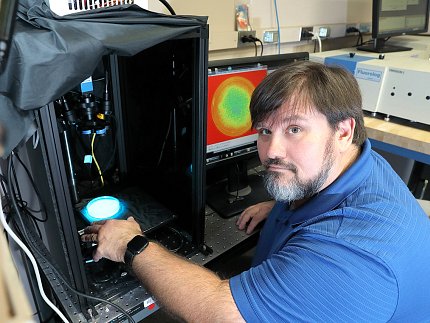NIBIB Investigator Patterson Is Mourned

Dr. George Patterson, a tenured senior investigator in the NIBIB intramural section on biophotonics, passed away on June 20 after a battle with cancer. He was 50.
A groundbreaking and world-renowned researcher in the development of photoactivatable fluorescent probe imaging, he was a respected global leader in the photoactivatable microscopy field and was widely considered unrivaled in the development of new methods using photoswitching and photoconversion of proteins.
Patterson joined NIH in 1999 as a postdoctoral fellow in the laboratory of Dr. Jennifer Lippincott-Schwartz in the National Institute of Child Health and Human Development. Four years later, he accepted a staff scientist position in Lippincott-Schwartz’s laboratory, collaborating with Drs. Eric Betzig and Harald Hess on their new PALM fluorescence imaging technique.
Patterson’s discoveries with photoactivatable genetically encoded proteins made fundamentally enabling contributions to the work that led to Betzig’s 2014 Nobel Prize in Chemistry.
Since starting his own lab at NIBIB in 2009, Patterson continued to innovate in the development of novel fluorescent proteins and their application to biological discovery. He was honored by the Royal Microscopical Society as 2021’s first recipient of the society’s Scientific Achievement Award. He received an NIH Director’s Award in 2016.
Patterson was an internationally respected pioneer in the development of probes and techniques for diffraction-limited and sub-diffraction limited fluorescence imaging, with more than 13,000 citations on the Web of Science, including 1,000 citations per year for the past 6 years.
“We are grateful for his groundbreaking scientific contributions and the opportunities many of us have had to work with and learn from George over his distinguished 22-year NIH career,” said NIBIB director Dr. Bruce Tromberg. “George created a warm and inclusive laboratory environment with an emphasis on interdisciplinary collaboration, and mentoring.”
Patterson provided valuable service to the NIH and greater biomedical communities, most recently as a proposal reviewer for the Chan-Zuckerberg Initiative; as a member of the Earl Stadtman investigator search committee (biomedical imaging/biophysics/physics); and on NIBIB’s anti-harassment working group.
He will also be remembered as an outstanding mentor with a commitment to recruiting diverse staff to his laboratory.
“Patterson’s passing is a great loss for his many colleagues and friends in NIBIB, around the NIH and around the world,” concluded a coworker.
He is survived by his wife Susanne Neumann, and children Isabella (11) and Max (9).
